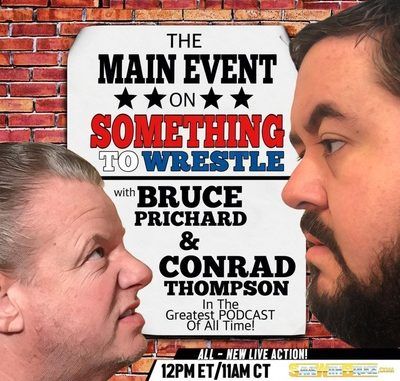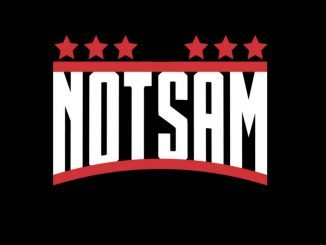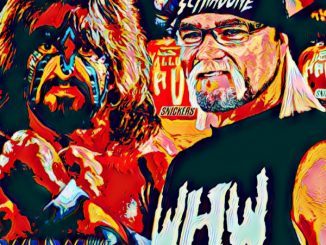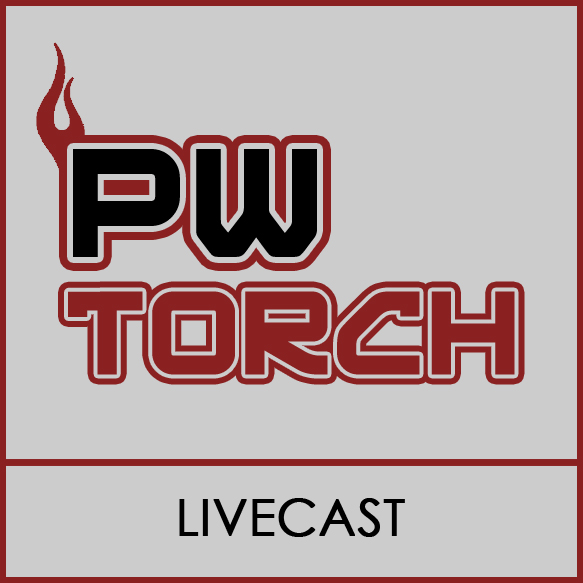
Something To Wrestle With Bruce Prichard – Episode 85
Recap by: Jeff Rush, PWPodcasts.com Assistant Editor
Air Date: 2/2/18
DIRECT LINK TO LISTEN/DOWNLOAD
Noteworthy Items
– How far in advance The Main Event was planned
– What Vince revealed at that meeting that shocked Bruce
– How the WWF intentionally spoiled WrestleMania IV
– The peculiar reason Indianapolis was chosen as the setting
– Why everything felt different than a normal WWF show
– The story behind Hulk’s epic workout video
– How Peggy Sue came to be
– Why Virgil never wore sleeves
– The battle Bruce lost over Dibiase’s promo
– Bruce’s conversation with Vince in Gorilla before the big match
– What Bruce thought was weird about the Twin Referee angle
The Main Event took place on February 5, 1988, at the Market Square Arena in Indianapolis, IN. It aired in prime time on Friday night on NBC and was the biggest broadcast in the history of the WWF in terms of both viewing audience and the importance it had on future events.
Bruce was 24 years old and put in charge of a production facility. He was intimidated, feeling this show was in some ways bigger than WrestleMania III.
The program was a partnership between Dick Ebersol’s company, Once A Month Productions, NBC, and the WWF. Everyone wanted to see what would happen with WWF receiving prime-time network exposure.
This was the first time pro wrestling was featured in prime time on network television since 1955. Bruce says it was appointment television. Everyone knew about WrestleMania III and there was still momentum from it.
Bruce first had the plan for the Main Event laid out to him in a meeting along with all the other department heads in October of 1987. Vince simply blurted out to the room that Hulk Hogan would drop the title at this show. He was shocked and felt uncomfortable as he was still relatively new to the company. In his previous experiences, such things were held close to the vest. He realized later how much prep work needed to be done by every other part of the company that it simply had to be done this way.
Titan Sports had sent all the information to media outlets regarding WrestleMania IV two months later as “ Hogan tries to regain his title.” Bruce felt this made a ton of sense. Now that everyone knows that it’s going to happen, they’ll now want to know how. Ideally, you’d keep it a secret, but they bit the bullet in an effort to advance promotion for WrestleMania.
Conrad asks if this fuels the fire for people outside of the WWF at the time who feel Vince McMahon is ruining the business. You can hear an audible sigh from Bruce at this point which seems to indicate an affirmative. Bruce likens this move to Eric Bischoff giving away Raw results on Nitro. He says everyone complaining about it were too busy trying to maintain kayfabe, they didn’t realize more interest was being created. He then admits it was a happy accident, they didn’t realize it would work out so well at that time.
WrestleMania III was financially speaking the biggest show for the company to this point, but this was the show that provided WWF with all the eyeballs on broadcast television. This wasn’t PPV, it was prime time broadcast TV and was so huge.
Indianapolis wasn’t one of the WWF’s major markets at this time, so it’s curious they chose to run such a show there. Bruce says the building looked great and that the company did, in fact, do good business in the city. It was one of their favorite buildings to run shows in. If Dick Ebersol could’ve run all the Saturday Night’s Main Events in Hershey, Sacramento, and Indianapolis, he would have because of how they looked on TV. The show probably would’ve been shot in Hershey if it wasn’t in Indianapolis.
Conrad reads through a report from the Wrestling Observer regarding ticket sales for WrestleMania IV in Atlantic City, including a note about the company “comping” 8,800 tickets. Bruce says the casinos in Atlantic City purchased the tickets; they were not given away. He notes it was great in that it alleviated any concern about ticket sales, but created some in regards to the indifference the people using these tickets would show towards the event. This was evident at both WrestleMania’s IV and V.
As Bruce recalls, Atlantic City was not a family-friendly environment at this point. He says the city lured the WWF in as part of an effort to change that stigma.
Conrad inquires about the dark matches that opened the show and what Bruce remembers about them. Bruce was so nervous and focused on the one-hour broadcast that he can’t recall anything else. He kept going over the program that night, making sure cameras were ready and audio was good.
Bruce was at Gorilla position queueing the show for the night. He says it’s literally the last place a wrestler is before they go out to the arena. His job here is to remind talent of how much time they have, where their queues are, where the commercial breaks are, etc. In 1988, it was just Bruce. Agents were out of the picture by this point in the night. Pat Patterson was the agent for both matches on this show and was probably already out in the arena. Bruce was left sitting at a table with a stopwatch.
The backstage promos featured backdrop graphics with the wrestler’s logos on them. This was done by Dick Ebersol’s company. They did this for Saturday Night’s Main Event and also handled all post-production. These promos were shot the day before this broadcast. Ebersol was there, but Vince was producing them. Bruce was “under the learning tree,” watching it all go down.
The verbiage was also provided by Ebersol’s company. Conrad points towards promos from Ted Dibiase and Honky Tonk Man that seemed different from what they would normally say. The wrestlers would get scripts and recite them word for word until they had them down. Vince would give revisions if he felt it wasn’t coming out right.
Next is a stand up of Jesse Ventura and Vince McMahon standing out in front of the crowd. Bruce says this was legit, that they didn’t start green screening until after WrestleMania IV.
From here, we cut to a Hulk Hogan training montage. It was oddly set to Jake Roberts entrance song. The guys discuss how, even though some fans of the show might take issue with this, they both loved it. It was a dark, gritty song that brought everything together.
Hulk was wearing all black in these workout scenes as opposed to wearing Hulk merchandise. Bruce says this was shot in a gym in NYC and Hogan was wearing what he normally worked out in. In later years, smartened up and saw to it that wrestlers were selling their merch as they worked out.
Honky Tonk came out with Peggy Sue. Bruce says Peggy Sue was Pat Patterson’s idea. The role was played by Sherri Martel and was done because the women’s roster was super thin. There was only so much you could do with Sherri, so they decided to create another character for her.
The mix from the truck was all messed up with bleed-over from the arena cutting into backstage promos. Everything is on a separate track these days, but what went on tape back then is what you were stuck with.
Conrad notices that Savage is pouring sweat in his interview, but then dry as a bone when he came out for his match. Bruce says extra precautions were taken via the use of polaroids to ensure consistency between shots taken on two separate days, but some things slipped through.
The wrestling rings back in the day were reinforced with a big spring in the middle of them so there wasn’t much give. There were so many 300lb plus guys working in the WWF back then that there was concern about the rings giving out. This made the rings much stiffer than any other. They would also implement the use of pads between the wood and metal to reduce the loud smacking sound you would hear when a body was slammed onto the mat. That was traditionally done so live audiences could hear the ring action in the back of the building. Vince hated it and didn’t want it sounding that way on TV.
The ring steps used this night were wooden. Bruce says these were the steps that came with the city. Nowadays they bring all their own equipment, back then they had to rely on what their suppliers in each region had. In this instance, Indianapolis hadn’t updated their steps just yet.
At this point in his run, the WWF was working on making Randy Savage more endearing to the audience. An example was how he would defend her against his villainous opponents.
The crowd was hot for everything on this night. Conrad brings up crowd sweetening, and Bruce says it’s always been in use, usually saved for long tapings when wrestlers would reappear several times. Everyone was waiting for Hulk-Andre on this night and the crowd was naturally all the way live.
Macho Man wins via countout and held the ropes open for Liz to exit and received a huge pop. This match and part of the show didn’t receive the greatest review from Dave Meltzer. Bruce feels the match told a great story and got Savage over to a national audience as a babyface. Randy looked good and Honky Tonk came off well as a chicken s**t heel. They were playing to a new audience and had to basically start over and explain everything they were doing and make it simplistic. So, while Meltzer may not have liked it from his perspective, it accomplished exactly what they wanted it to.
Here we move onto the main event. We start with the backstage promo by Dibiase, Virgil, and Andre. Conrad wants to know why Virgil never wore sleeves. This was Vince’s idea as he loved Virgil’s arms. As a result, he never wore sleeves.
Bruce tells a quick story about having had breakfast with Ted Dibiase this past week following Raw 25. Bruce was picking up the tab, but stopped and questioned why Dibiase didn’t pick it up and have Vince write it off, as that was his old gimmick.
The guys discuss the quality of all the promos delivered on the show. Conrad feels they’re perhaps the best ever, collectively. Bruce pushed hard to have Dibiase close his promo with his trademark “Everybody’s got a price,” but Vince sided with Ebersol’s team, feeling the pun-laden promo was enough. Even giants have a price, argued Prichard, thusly it made more sense than ever to close out a promo with the line, but to no avail.
At one point in the match, Vince referred to one of Hogan’s punches as a Sunday punch. This was called by this name because it meant the person delivering the punch would put their target out until Sunday. This leads us to a Dusty impression.
Hogan climbed to the top rope in order to have Andre slam him. Hogan didn’t do such a thing often, but was willing to do so for Andre.
At numerous times throughout the show, Conrad puts over the show big time. It’s only 49 minutes long and is a must-see, even 30 years later. Bruce feels it holds up entirely.
The crowd was huge into Hogan, and Conrad points out this was a different Hogan than we’re used to. It seems he was inspired to be working with Andre again and, following WrestleMania III, was willing to work extra hard to make this match memorable.
Andre hip-tossed Hogan, which was referred to by McMahon as a suplex, and covered Hogan. Even though his shoulder was clearly up at one, the referee counted a quick three. Andre was crowned the new Heavyweight Champion, even though he then memorably announced he was surrendering the “World Tag Team Championship” to the Million Dollar Man. This had major heat with the live crowd.
Bruce enjoyed the hell out of the whole thing. He feels it was a simple story but was told masterfully. The crowd felt every emotion they were meant to feel and it was all wrapped up in approximately 10 minutes.
After the match, the famous “twin referee” angle was revealed. Dave Hebner was a WWF mainstay at this point, and Earl had just arrived from the NWA a few months earlier.
While sitting in Gorilla prior to the match, Bruce was approached by Vince. Vince asked if he wanted to know the finish, and Bruce declined. He chose to watch it as a fan and is so glad he did. He was mesmerized by what unfolded. He feels this finish goes down in history as the greatest of all time.
Earl reveals himself to be the heel ref by hitting and kicking Dave. At this point, Hogan picked up Earl and threw him out of the ring. Dibiase and crew were supposed to break his fall but missed him completely. Bruce says he wasn’t hurt, even though it was a crazy bump and that Earl was happy as could be backstage afterward.
Bruce thought it was weird that there was no explanation given after this show as to what happened to the “evil” ref. They simply moved Earl into the rotation.
Bruce loved Hogan’s distraught backstage promo that closed out the show.
There was no internal concern over WrestleMania IV running under a tournament format, as Vince felt strongly that the guaranteed return match between Hogan and Andre would be enough to sell the show.
The network was ecstatic with the huge success of the show.
Review: Bruce and Conrad are not much for brevity, and this was the first episode to finish under the two-hour mark in some time. I, for one, love the shorter format. Don’t get me wrong, where WWE misses the mark with their more-is-better method for three hours on Monday nights, the ground covered on this show is always high quality, whether it’s two or five hours. What’s cool about the tidier subjects such as a single 49-minute broadcast from 1988, is that it allows Conrad to delve deep into the details – backstory on why certain camera angles were used, who designed the background graphics, etc. For this very reason, I would love to see a subject like Goldust split into two or three two-hour episodes instead of being carried out in full in one five-hour haul.
The subject matter this week was terrific. For any fan in the mid-30’s to mid-40’s range, this is primarily what we remember about wrestling from our childhood. I’ve honestly thought, even momentarily, about this show every February 5th since 1988.
It’s also cool to hear Bruce reflect on something that took place so early in his career, and the Main Event was such a big deal, he even admits to not remembering anything else that night but what happened within that one-hour window.
Kudos to the shorter format, and to the attention to detail that went with it. Of course, an additional kudos from this listener for the subject matter. What the show lacked in impressions, anecdotes, and arguments, it more than made up for with the aforementioned qualities. Rating 9/10
Time Stamps
9:00: Show begins/setting the groundwork
19:55: Market Square Arena
20:54: Ticket sales for WrestleMania IV
30:43: The preshow
36:06: The Main Event broadcast
42:23: Hulk Hogan training montage
45:50: Honky Tonk Man vs. Randy Savage
1:07:00: Hulk vs. Andre
1:34:39: The aftermath
1:36:40: Twitter questions




Be the first to comment